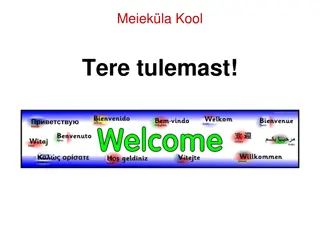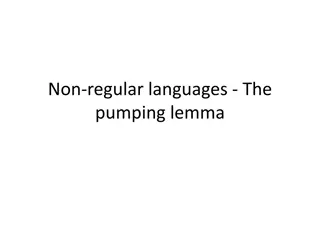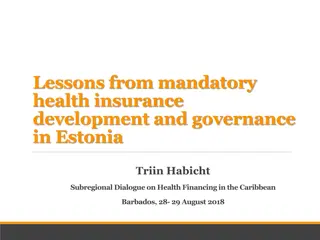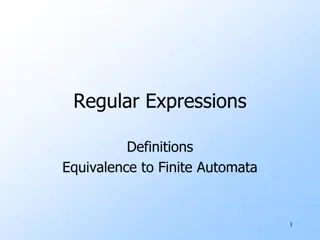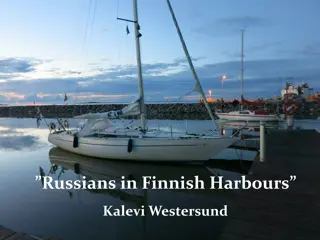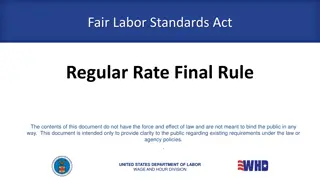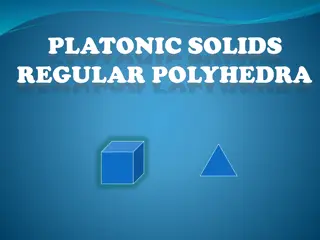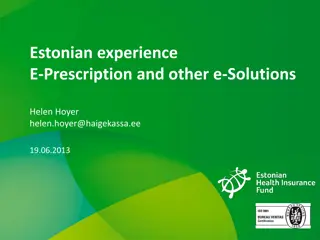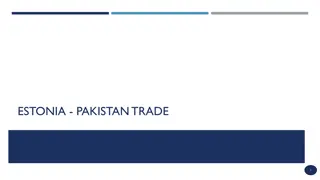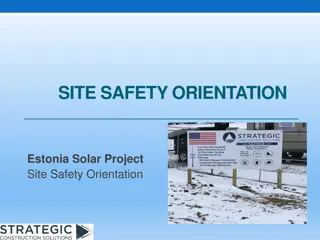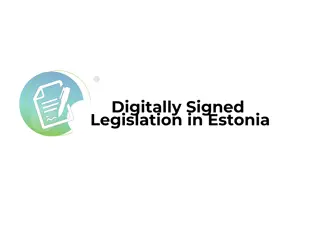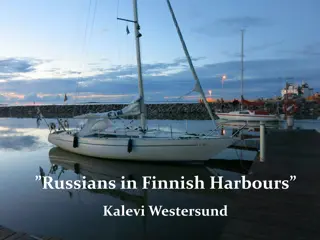Overview of Regular Evaluation 2017 Findings in Estonia
In the Regular Evaluation 2017, efforts were made to maximize the benefits of evaluation outcomes for various stakeholders in Estonia such as the state, society, and institutions. The evaluation focused on a range of actions including preparing legislation, finding experts, creating self-report forms, organizing site visits, and compiling evaluation reports. The evaluation process involved assessing wider outputs, positive/negative results, scientific impact, sustainability, and societal impacts. Notable conclusions highlighted Estonian research competitiveness, forward-looking orientation, societal contributions, strong research infrastructure, but identified shortcomings in funding stability, reliance on EU funds, and lengthy doctoral studies. These insights aim to guide improvements in Estonia's research landscape.
Download Presentation

Please find below an Image/Link to download the presentation.
The content on the website is provided AS IS for your information and personal use only. It may not be sold, licensed, or shared on other websites without obtaining consent from the author.If you encounter any issues during the download, it is possible that the publisher has removed the file from their server.
You are allowed to download the files provided on this website for personal or commercial use, subject to the condition that they are used lawfully. All files are the property of their respective owners.
The content on the website is provided AS IS for your information and personal use only. It may not be sold, licensed, or shared on other websites without obtaining consent from the author.
E N D
Presentation Transcript
Regular evaluation 2017 Doris Pavlov R&D analyst 07.09.2017
Carrying out RE 2017 - Main goal: maximize the benefits of evaluation outcomes for the state, society and institutions, optimize work load for institutions (partially pre- filled evaluation forms) - Actions taken: - Preparing and compiling legislation, regulations and evaluation forms; - Finding experts with broad expertise and experience in conducting, managing and evaluating research; - Operating the process of creating and composing the self-report forms, briefing experts; - Organizing site visits; - Coordinating the compilation of evaluation reports
2010 vs 2017 Differences 2010 2017 Wider output for the state and institution * positive/negative result; * comments * positive/negative result; *evaluations of scientific impact, sustainability and potential and societal impact on 4-level scale; *evaluation on scientific basis to conduct doctoral studies; *areas of special note or in need of improvement if appropriate; *feedback for institutions if appropriate; * suggestions for unit, institution, state, Number of experts Different fields 16 22 *Biosciences and environment; *Culture and Society; *Health; *Natural Sciences and Engineering * Natural Sciences; * Engineering and Technology; * Medical and Health Sciences; * Agricultural and Veterinary Sciences; * Social Sciences; * Humanities and the arts
Evaluation in numbers 21 applicants, 38 applications from 6 fields of science 22 foreign experts from 8 European countries Duration 1 year ((from legislation to the outcome), including 1week for site visits)) Budget - 100 000 euros Outcomes: 36 positively evaluated applications from 20 institutions (from which 5 private, 15 public) 2 institutions had previous positive outcomes from 2015
Some preliminary conclusions of RE 2017 Estonian research is internationally competitive Estonian research is oriented to the future Estonian research serves society in many different ways Research infrastructure is at very good international level Main bottleneck in the Estonian Research System is the instability of financing and dependence on EU structural funds Also, duration of doctoral studies is too long due to low financing and rigid graduation requirements
Thank you for the institutions for the great experience and thank you for the experts for their remarkable contribution!







